The supply of electricity to a house underground is a labor-intensive process, but it is quite doable with your own hands. The issue is especially relevant for the electrification of private houses, summer cottages and garden plots. Installation of electrical equipment is carried out in accordance with the standards of GOST and PUE.
Benefits and vulnerabilities of underground electrification
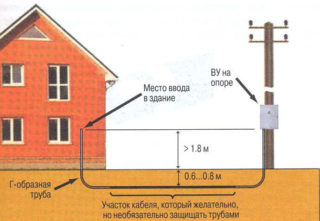
Entering an electric cable into a house underground instead of overhead lines has a number of advantages:
- does not spoil the architecture and design of the site;
- does not experience atmospheric influences;
- high fire safety.
In addition, the liner made in this way is protected from theft and vandalism. This is especially important if the building is left unattended for a long time.
Underground laying of an electric cable has some negative points:
- can be subjected to mechanical stress in the process of swelling and subsidence of the soil;
- influence of groundwater, soil freezing, root pressure of large trees;
- insects and rodents can damage the wiring;
- it is subject to aging and corrosion.
The durability of electrical wiring depends on the composition of the soil and its saturation with water, thermal vibrations and vibration processes.
Obtaining permission for underground input
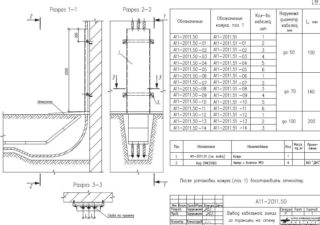
First you need to complete the project. Its development should be carried out by a specialist. Technical documentation, plans and drawings must comply with all rules and regulations. The designer determines the brand of the cable, calculates the cross-section of the conductive cores.
To get a project, you must fulfill a number of technical conditions. To connect the house to a common power line, an appropriate permit is required. For example, an agreement for earthworks is drawn up by the service responsible for objects and communications.
Then the tracing of the land plot is carried out. If there are any communications in the immediate vicinity of the cable to be laid, it is necessary to invite their representative to agree on the position of the trench and control the work being carried out.
Compliance of cable products

To bring electricity to the house, use products intended for laying in the ground. Since the electric cable will be under the pressure of the soil mass, products in a special braid and armor are used. These are such brands as, VB bShv and VB bShVng. The first letter in the marking indicates the presence of copper conductors. Reservation is made with corrugated steel tape. It is wound in the form of a spiral, along the inner layer of insulation.
Products are resistant to mechanical damage. Installation can be done without piping. However, in order to avoid damage during operation, it is recommended to use a pipe. If the earth has an increased chemical activity - salt marshes, swamps, slags, construction waste - use a cable with lead armor or aluminum sheath.
Considering the laboriousness of the installation work, it is better to choose a high-quality cable right away, even if it is more expensive.
Entry using non-armored cable and HDPE pipe
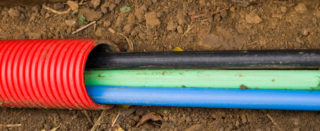
If you need to supply electricity underground in the country, you can use a regular PVC-sheathed wire. For laying in the ground, it is better to choose sealed and sufficiently strong brands of cable products - NYM, VVG or SIP.They can be used, for example, to conduct lighting in a suburban cellar. However, products under active external influence fail quickly enough.
To extend the service life, pipes made of low pressure polyethylene (HDPE) are used as protection. They reliably protect against stray currents, mechanical damage and the influence of aggressive soil. For this purpose, you can use corrugated products. They have increased elasticity and strength, easily restore their linear dimensions, and are easy to install. With frequent repairs, they can be reused. Some models are equipped with a probe, which makes it easier to pull the cable into the corrugation.
Cable management
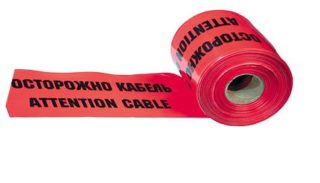
The standard for the depth of the trench is 90 cm, the thickness of the sand cushion is up to 20 cm. The cable is laid without tension, in a wave-like manner, always below the freezing point of the soil. Then it is covered with a layer of sand 30 cm and earth, after having laid a warning tape.
If the soil is susceptible to shear, not dense enough, saturated with groundwater, additional protection is installed. A tray is made of concrete blocks or moisture-resistant bricks. The cable is laid in a tray and covered with a concrete slab on top. On creeping soil, a reinforced concrete monolithic channel is made and closed with reinforced slabs.
Cable outlet
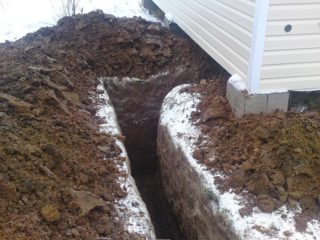
At the exit from the ground, before connecting to the pole, a 2 meter section of the cable should be closed with a curved metal pipe. The bending radius is at least 20 diameters of the cable sheath.
When laying a cable in the ground in the country, it should be introduced to the house through the foundation, for this you need to provide a mortgage. This is a piece of pipe extending 10-15 centimeters from the foundation on both sides. Its cross-section should be 4 times larger than the wire to be laid. Through it it is easy to enter the cable into the room. For subsequent sealing, use polyurethane foam or rags soaked in cement milk.
In another method, a cable in a metal pipe is lifted along the house. This is usually where the introductory cabinet hangs. The mortgage is made in the wall, adhering to the same parameters, and the wire is brought into the house. This method is used if the foundation is made of a monolithic slab and you don't want to break it.
You can lay the electrical cable underground using the puncture method. This method is used if the wiring must be laid under a section of a road or garden path. The essence of the method is to create a channel by pressing a metal pipe with a tip into the ground. In this case, the soil around the device is compacted.
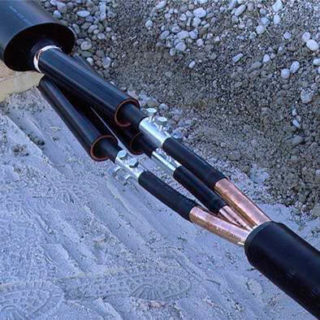
On both sides of the obstacle, two pits are made, one for the starting, the other for the reception. On the pipe, using a grinder, teeth are cut in the form of a crown. The diameter should correspond to the dimensions of the wire, but not less than 20 mm.
It is better to do the work together. The end of the pipe with a crown is installed in the starting pit. The other end is hit with a sledgehammer with great force. After passing 50 cm of the path, the inner part of the pipe is washed from the ground with water under pressure.
If there is not enough length to the receiving pit, an additional segment is welded. When the teeth of the crown appear on the other side, the process is over. The protruding ends on both sides are cut off, and the cable is inserted into the middle part. In this case, the pipe remaining in the ground is a protection.
Cautions
An underground cable for electricity in a private house should only be armored.
The metal pipe for wiring should not be solid, since when it is filled with groundwater, the ice formed in severe frost will damage the cable.
The wiring must be grounded. For this, a separate insulated wire is soldered to the armor. The other end is connected to ground at the shield or zero terminal. In the event of an emergency, the machine will cut off the power supply.
Choosing the right cable, observing all the requirements for its installation, is the basis for a long and safe operation of the electrical line.








